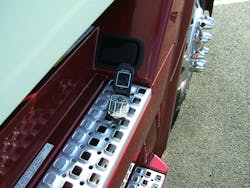Mobile Communications: Debating BYOD vs. COPE in trucking
There is a growing debate within the trucking industry regarding mobile communication technology as to whether a so-called “Bring Your Own Device” or “BYOD” approach is more beneficial or detrimental compared to the more traditional “Company-Owned Personally Enabled” or “COPE” strategy, especially in terms of security, privacy, cost and supportability issues.
“This is a red-hot topic being driven by the onslaught of smart communication devices, and it can be quite confusing,” Brian McLaughlin, president of technology provider PeopleNet, explained to Fleet Owner.
“BYOD, which has been fueled by the incredible surge in consumer products like smart phones, utilizes off the shelf technology, built for single users, with control distributed on a per device basis. In other words, consumers can turn things on/off and share information at their discretion,” he said.
“But this distributed empowerment can, unfortunately, lead to downloading, web surfing, and communicating sensitive information intentionally or inadvertently,” McLaughlin stressed. It can also hurt economically, he noted, pointing to a current PeopleNet trucking customer using a BYOD solution that got “surprised” by hundreds of dollars in unplanned monthly service charges per smart phone.
PeopleNet lays out the pros and cons to each side of this mobile technology debate in a new “blue paper” while focusing on two key questions: Should drivers be allowed to connect their personally owned devices to the company network as well as use company-owned devices for personal as well as business use?
McLaughlin told Fleet Owner that PeopleNet’s research found that a COPE strategy is the preferred approach for many in the industry as it blends the best attributes of reliable, robust solutions with the selective empowerment enabled by corporate controls.
“COPE allows fleets to standardize on a solution to ensure consistent performance, but allows flexibility to implement -- or turn off -- additional capabilities,” he explained. “Since a standard solution is implemented, the fleet has much better knowledge of how to use/disable certain features/apps.”
By contrast, McLaughlin said BYOD can “trick you” as it’s typically lower cost to adopt on the front end, but ends up costing more over time.
“Although COPE has higher costs initially, it has the lowest total cost of ownership,” he argued. “The typical fleet technology implementation is 5 to 7 years. Fleets have found that changing onboard equipment more frequently is simply too costly.”
And not just for the cost of the solution, either, but the change management costs as well – costs to procure, install, train, and change technologies, McLaughlin said.
“The greatest risk is managing change,” he emphasized. “When adopting a BYOD approach, there are thousands of possible configurations of hardware, operating systems, applications, communications, security, and control. This degree of complexity, while enjoyed by the individual user, puts an incredible strain on the fleet manager.”
For example, McLaughlin pointed to California, which has now stated that if a fleet uses a driver’s phone for business communication, the business must pay for that phone’s entire cost. “Fleets cannot handle that degree of change and constant management when they need to be focused on recruiting drivers, finding loads, spec’ing equipment, etc.,” he added.
About the Author
Sean Kilcarr
Editor in Chief
Sean Kilcarr is a former longtime FleetOwner senior editor who wrote for the publication from 2000 to 2018. He served as editor-in-chief from 2017 to 2018.
